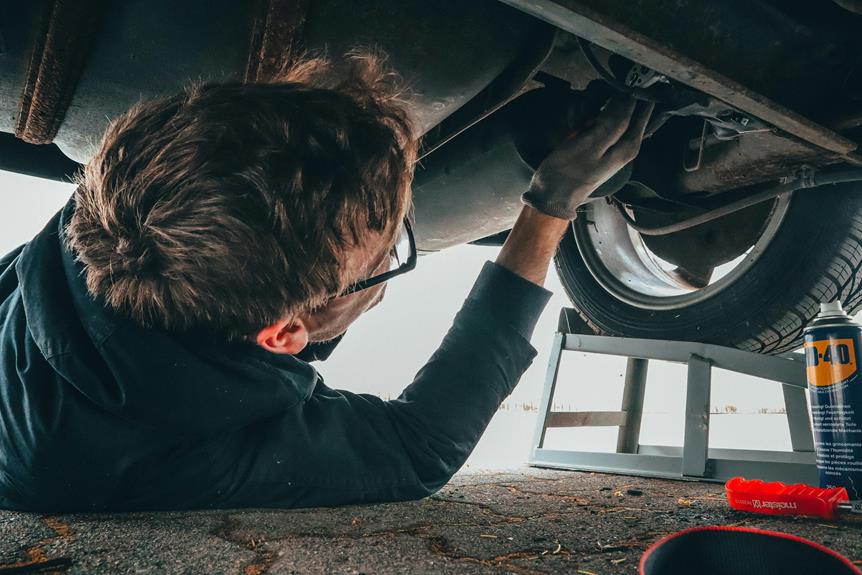
Take control of your car's maintenance by changing the oil regularly. All you need are supplies like new oil, oil filter, wrench, funnel, and drain pan. Park on a level surface, find the oil drain plug underneath, use a wrench to loosen it, and drain the old oil. Don't forget to check tire pressure monthly, look for recommended pressure, use a gauge, and fill if low with an air compressor. Replace air filters by locating the housing, opening it, removing the old filter, and installing a new one correctly. Always inspect brake pads by locating the metal rotor, finding the brake caliper, checking pad thickness, and listening/watching for signs. These DIY tasks can help you save time and money.
Changing Oil
When conducting DIY car maintenance, the first essential task to learn is changing the oil. It's crucial to keep your car's engine running smoothly by regularly changing the oil.
Begin by gathering the necessary supplies: new oil, an oil filter, a wrench, a funnel, and a drain pan. Make sure your car is parked on a level surface and is cool before starting.
First, locate the oil drain plug underneath your car. Position the drain pan underneath and use the wrench to loosen the plug. Let the old oil drain completely before replacing the plug.
Next, find the oil filter and use the wrench to remove it. Be careful, as some oil may still be inside.
After removing the old filter, lubricate the rubber gasket on the new filter with fresh oil. Then, screw the new filter into place.
Checking Tire Pressure
To ensure your DIY car maintenance routine is comprehensive, let's now focus on checking tire pressure. Proper tire pressure is crucial for your safety on the road and for maintaining optimal fuel efficiency.
Start by locating the recommended tire pressure for your vehicle, which is usually found in the owner's manual or on a sticker inside the driver's side door jamb. Using a tire pressure gauge, unscrew the valve caps on each tire and firmly press the gauge onto the valve stem to measure the pressure. Compare the reading to the recommended pressure; if it's low, use an air compressor to fill the tire to the correct level. Overinflated tires can be just as dangerous as underinflated ones, so be sure not to exceed the recommended pressure.
Check the tire pressure monthly and before long trips, as temperature changes can affect tire pressure. By regularly monitoring and maintaining proper tire pressure, you'll ensure a safer and more efficient driving experience.
Replacing Air Filters
For optimal engine performance, regularly replace your air filters. Air filters prevent dirt and debris from entering your engine, ensuring it runs smoothly. Replacing them is a simple task that you can easily do yourself.
To begin, locate your air filter housing. This is often a black plastic box near the front of your engine. Open the housing by unclipping the latches or unscrewing the fasteners.
Once the housing is open, take out the old air filter. Check its condition – if it's dirty or clogged, it's definitely time for a new one. Make sure to note the direction the filter faces to install the new one correctly.
Next, place the new filter into the housing, ensuring it sits snugly. Close the housing securely, making sure all latches or screws are fastened properly.
Regularly replacing your air filters improves fuel efficiency and prolongs your engine's lifespan. This simple maintenance task can be done in just a few minutes, so don't overlook its importance.
Inspecting Brake Pads
Regularly maintaining your vehicle also involves inspecting your brake pads to ensure optimal safety and performance.
To check your brake pads, start by looking through the spokes of your wheel to locate the shiny metal rotor. Next, locate the brake caliper, which holds the brake pads. The brake pads should be at least a quarter inch thick; if they're thinner, it's time to replace them.
Also, keep an eye out for any unusual sounds when braking, as this could indicate worn-out brake pads. Another sign to watch for is if your vehicle pulls to one side when braking, which could suggest uneven brake pad wear.
If you notice any of these signs or if you're unsure about the condition of your brake pads, it's best to consult a professional mechanic to ensure your brakes are in top working condition. Regular inspection and maintenance of your brake pads are crucial for safe driving and optimal vehicle performance.
Conclusion
In conclusion, maintaining your car doesn't have to be daunting. By taking on simple tasks like changing oil, checking tire pressure, replacing air filters, and inspecting brake pads yourself, you can save money and keep your vehicle running smoothly.
With a little effort and some basic tools, you can tackle these tasks with confidence and keep your car in top condition. So don't hesitate to take on DIY car maintenance – you'll be glad you did!




